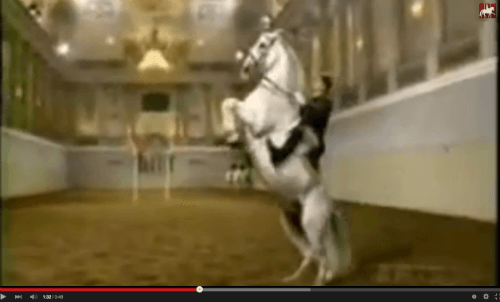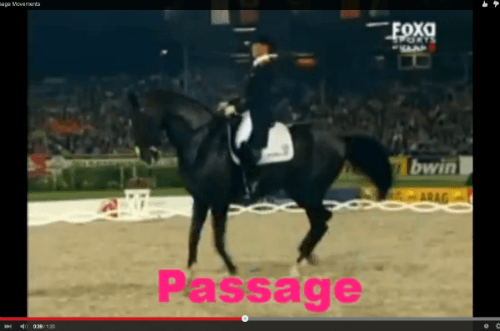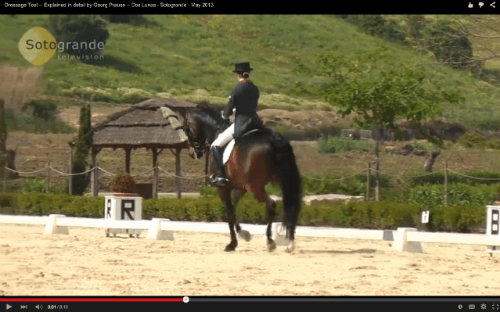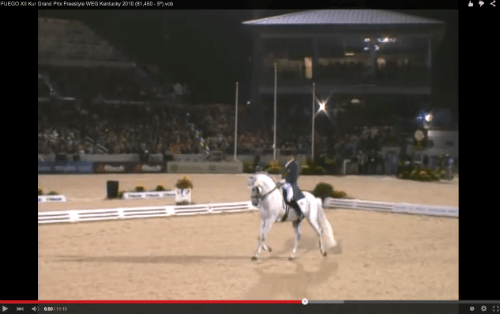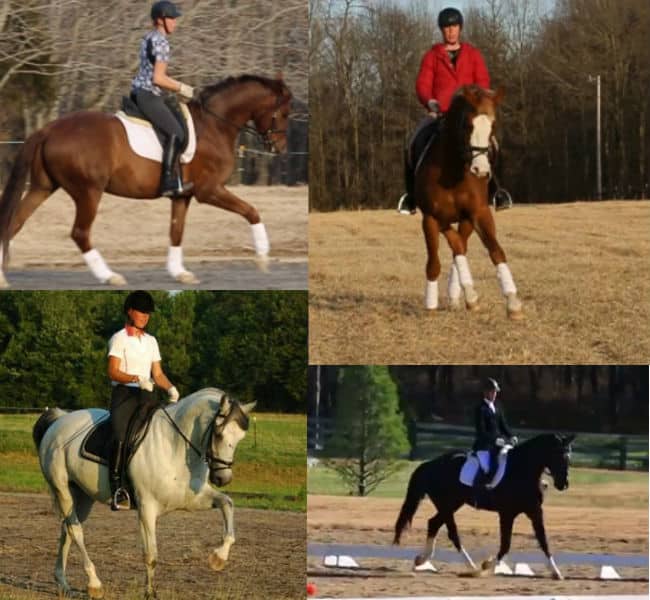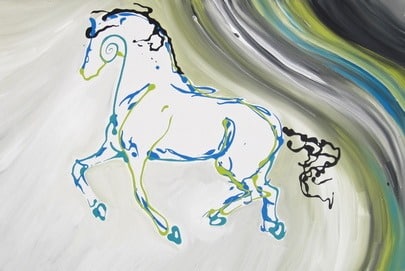Dressage Secrets Revealed: How This Classical Riding Style Can Help ANY Breed in ANY Discipline
Dressage is considered by many to be the ultimate pairing of horse and rider. It is a beautiful athletic display of precise movement and grace. For equestrians in other disciplines, it can often be hard to fully appreciate and understand competitive dressage. To help, we’ve talked with a talented dressage rider and trainer named Emily McIntosh of Clarksville, TN. She has helped us create this beginner’s dressage guide so you can better appreciate this form of horsemanship. You will learn how this classic form of training can benefit any breed of horse in any riding discipline.
What is Dressage?
Dressage is a truly beautiful form of horse back riding that requires incredible athleticism from horse and rider. Emily explained, “I love that dressage focuses on the harmonious relationship between horse and rider…in dressage, it is one of the main criteria judged in every movement.”
The word dressage is French for “training” and this form of riding evolved as basic training for the military. Emily explained, “If you’re risking your life on the battlefield, you want a responsive, agile horse that can quickly respond to aids unseen by the enemy.” In fact, many of the haute ecole (or High School advanced training) moves were used in battle. For example, the capriole is an advanced move where the horse jumps in the air and kicks out. During the Renaissance, dressage became appreciated as an art form. Emily went on to explain that the Spanish Riding School of Vienna (famous for its Lipizzaner Stallions) has preserved the art of training horses to haute ecole. Be sure to view some of their impressive riding here:
Today, dressage is performed at shows worldwide. In the United States, the top riders will travel with their living quarters horse trailers to compete at the Dressage at Devon horse show each fall in Pennsylvania. They may also travel to the World Equestrian Games and Olympics. The dressage ring is 20x60 meters in size and has letters posted around the arena to provide markers for where required moves should be performed.
What are some of the skills and moves in dressage?
Dressage has often been described as ballet on horseback. The horse and rider work together to perform complex moves that appear effortless and flow gracefully from one to the next. In reality, this type of riding takes a very high level of athleticism and communication between the horse and rider. Lateral movements are any moves where the horse and rider are moving in a direction other than straight forward. To help understand some of the higher-level moves, check out this explanatory video with several dressage examples:
This video shows some of the classic dressage moves.
What are the levels of competition?
The highest level of dressage competition is the Grand Prix level, which can be seen at the Olympics and World Equestrian Games. Many lower levels exist to make the sport more accessible to those developing their skills. Emily provided the following descriptions for each level.
Intro: free walk, medium walk, working trot, working canter, halt, 20m circle
Training level: stretchy trot circle
First level: trot lengthening, canter lengthening,
Second level: collected walk, collected trot, collected canter, medium trot, medium canter, shoulder-in, renvers, travers, turn-on-the-haunches
Third level: flying changes, half-pass, extended trot, extended canter, walk pirouettes, extended walk
Fourth level: canter pirouettes, multiple flying changes across a diagonal
Prix St. George: five flying changes every 4th and every 3rd stride
Intermediate: Flying changes every stride and every 2nd stride, piaffe, passage
Grand Prix: Same movements as Intermediate, but a more demanding sequence
Emily explained, “Lower level dressage is quite similar to hunter or equitation classes; however, I love that in dressage it doesn’t end when you’ve mastered obedient basic gaits. There are higher levels to work towards.” She continued, “You may help your horse achieve the best balance and most dance-like movement he/she is capable.” Here is a Prix St. George level dressage test explained step by step:
What are judges looking for during a Dressage test?
Judges look for a number of things when a horse and rider pair enters the ring. Emily explained, “They look for a harmonious pair with the horse moving freely forward, in-balance, and happily responding to invisible (or nearly invisible) aids from the rider.” A dressage test is made of a series of movements ranging in difficulty from a simple walk-trot transition to a more complex piaffe.
How are Dressage tests scored?
Collective marks are given at the end of a test for the overall impression and include marks on the gaits, impulsion, submission, rider position, rider effectiveness, and geometry. Emily explained, “Each collective mark and every movement in a test receives a score. All the scores range from 0-10. Most scores are in competition between 4 (insufficient) and 8 (very good). Scores are added together and divided by the maximum points possible to get a percentage. Dressage scores typically range from around 55% to 70%.”
What breed of horse can benefit from Dressage training?
Emily stressed that any breed of horse can benefit from dressage training. “Correct dressage training should increase the longevity of the horse by helping the horse to use their body in a more efficient way – better balanced and free of tension and resistance. This makes it easier for the horse to carry out what we ask and should be more comfortable to ride.”
Warmbloods are often used in competitive dressage because they have loose ground covering gaits that provide a huge ‘wow’ factor. Sometimes, these large animals have trouble collecting for the upper levels. Emily explained that Iberian horses like Andalusians and Lusitanos have shorter strong backs and hindquarters that make collection in the upper levels relatively easy. Iberian horses cannot naturally extend their gaits as easily as warmbloods, but extension can be achieved with proper training. For example, the musical freestyle video show below is of an Andalusian horse with a beautiful extended trot.
How Can Dressage Benefit Horses in Other Disciplines?
Basic dressage training can benefit horses in many different disciplines. The principles of balance, correct body movement, and rider to horse communication will help you be more attune with your horse during performance. Even a rider focused on western style riding can improve their horse’s performance by using the basic elements of dressage. Ultimately, dressage can help your horse use their body in a more efficient way, be better balanced, and allow a more harmonious relationship with the rider.
Musical Freestyle – The Ultimate Dancing Horse
One of Emily’s favorite elements of dressage is most certainly the musical freestyle. “Musical freestyle is what drew me towards dressage. The rider may choose their own music and design the choreography to best show off their particular horse’s strengths.” She continued, “Musical freestyle’s are much more fun to watch especially for someone unfamiliar with dressage since the horse basically dances to the music. In dressage, we’re building an athlete to have more dance-like movement. It makes sense that the dance should be to music.” Emily shared one of her favorite musical freestyle rides performed by Spanish rider Juan Manuel Munoz Diaz riding Fuego below:
Emily’s Dressage Journey…So Far
Emily admits that she grew up as a typical horse-crazy kid in middle Tennessee. “My parents did not think they would have anything to do with horses, but through a lot of persistence, I eventually convinced them,” she shared. She began taking lessons with a variety of instructors on several different horses. In a way, she was fortunate to ride with so many different horses and instructors because it helped improve her feel and helped her gradually discover which training techniques tended to work best with different breeds and horse personalities. “When I began training horses, I’d purposely train every horse slightly differently to see which methods helped each particular horse learn the best.”
Emily trains dressage horses and riding students at her farm Serendipity Stables in Clarksville, TN.
Once she was actually training horses in dressage, she left to train with the riding masters of Europe. “I went to Portugal and realized I was a beginner!” She continued, “I highly recommend dedicated riders who want to reach the top of the sport work with the best of the best as soon as possible.” She cites experts like Jorge Sousa, Jeannette Jenny, Ed Rothkranz, and JT Burnley who helped her become the rider she is today. Emily has big goals for her work with dressage. “My long term goal is to bring an unstarted horse up the levels to Grand Prix.” She now works at her farm in Clarksville Tennessee called Serendipity Stables where she provides dressage riding lessons, training for horses, and also develops her own horses for future competitions. Emily is also a talented artist and creates contemporary equine artwork that she sells.
Emily’s contemporary equine artwork is for sale on her art website.
“My current goals are to keep the horses happy and relaxed in their work while gradually bringing them up the levels.” This past year was a strong year for her horses being shown at Training level. “They each earned a 79% so I am thrilled. I’d like to continue on that track (happy, willing athletes that can effortlessly perform the movements required) as they move up the levels.” She has one horse in particular who is excelling with his training and does easy lateral work, piaffes, and a nice schooling canter (almost cantering in place). “I’m super excited about his fantastic attitude and how well he’s handling the demands of upper level work.” In dressage, Emily says that you are slowly creating an athlete over a period of five to ten years. She said, “It’s a long journey, but as the quote goes: ‘Life is a journey, not a destination.’ Good luck on your dressage journey!”
To learn more about dressage, check out the U.S. Dressage Federation website. Also, if you live in middle Tennessee or Kentucky, be sure to look up Serendipity Stables to train with Emily McIntosh.
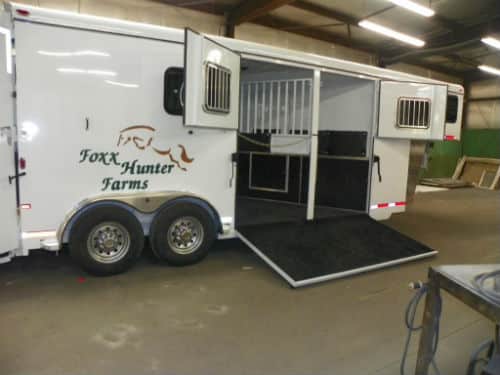
Questions:
*What are some questions that you have for Emily on getting started in dressage?
*How have elements of dressage training helped with your riding discipline?


